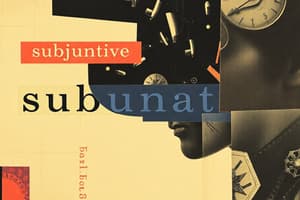Podcast
Questions and Answers
What is the subjunctive mood usually used to express?
What is the subjunctive mood usually used to express?
- Hypotheses and predictions
- Commands and orders
- Feelings, influence, and doubt/uncertainty (correct)
- Facts and concrete information
How do you form the present subjunctive of regular verbs?
How do you form the present subjunctive of regular verbs?
- By swapping over ar, er, ir endings (correct)
- By adding -ing to the base form of the verb
- By using a different verb altogether
- By adding -ed to the base form of the verb
What is the present subjunctive form of 'querer' in the first person singular?
What is the present subjunctive form of 'querer' in the first person singular?
- Quiero
- Quiera (correct)
- Quieras
- Queremos
Which of the following verbs is completely irregular in the present subjunctive?
Which of the following verbs is completely irregular in the present subjunctive?
What is the present subjunctive form of 'conducir' in the first person singular?
What is the present subjunctive form of 'conducir' in the first person singular?
Why do some radical changing verbs ending in -ir have an additional change in the nosotros and vosotros forms?
Why do some radical changing verbs ending in -ir have an additional change in the nosotros and vosotros forms?
What is the present subjunctive form of 'ser' in the first person singular?
What is the present subjunctive form of 'ser' in the first person singular?
What happens to irregular verbs in the present indicative when forming the present subjunctive?
What happens to irregular verbs in the present indicative when forming the present subjunctive?
Flashcards are hidden until you start studying
Study Notes
The Subjunctive Mood
- The subjunctive is not a tense but a mood, which can express the present, future, and past.
- The subjunctive mood is used to express feelings, influence, and doubt/uncertainty.
Formation of the Present Subjunctive
- For regular verbs:
- Swap ar, er, ir endings to form the present subjunctive.
- Examples: Trabajar (to work), Comer (to eat), Vivir (to live)
- For irregular verbs:
Radical Changing Verbs
- Follow the same pattern as the present tense, but with changing endings.
- Examples: Querer (to want), Volver (to return), Pedir (to ask), Dormir (to sleep)
Completely Irregular Verbs
- Ser, Estar, Haber, Ir, Saber, and Dar have unique forms in the present subjunctive.
- Examples: Ser (to be), Estar (to be), Haber (to have), Ir (to go), Saber (to know), Dar (to give)
Verbs Irregular in the First Person
- Verbs that are irregular in the present indicative will carry this irregularity through in the present subjunctive.
- Examples: Conducir (to drive), Tener (to have), Decir (to say), Salir (to leave)
Studying That Suits You
Use AI to generate personalized quizzes and flashcards to suit your learning preferences.




